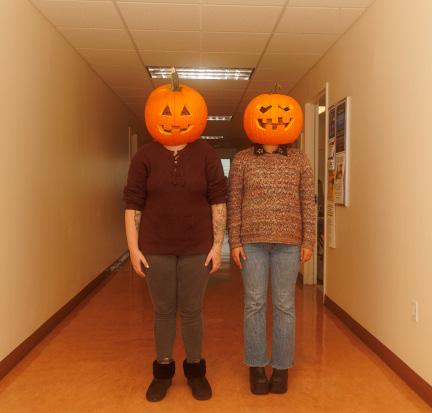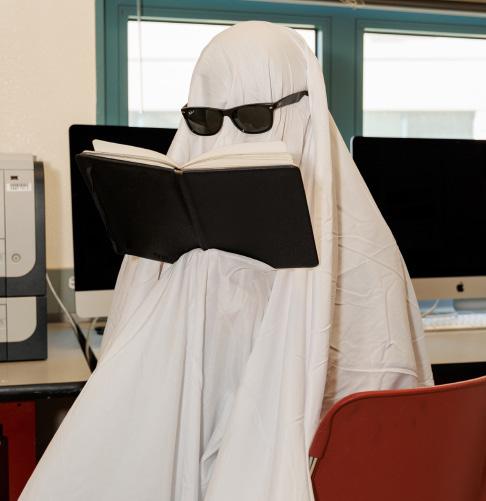












WILL I SEE YOU AGAIN? - THEE SACRED SOULS 4:00

ROSEMARY - DEFTONES 6:53
BAG LADY - ERYKAH BADU 5:48
NELLY - ISAIAH RASHAD 3:20
TEMPTATION - RAVEENA 4:08
ETERNAL LIGHT - FREE NATIONALS 3:13
CREEP - RADIOHEAD 3:48
LA LLORONA - NATALIA LAFOURCADE 6:55
AMOR COMPLETO - MON LAFERTE 4:01
SABOR A MI - EYDIE GORME, LOS PANCHOS 2:48
JSTFRIENDS - KNXWLEDGE 4:00
GENESIS - GRIMES 4:15
PYRAMIDS - FRANK OCEAN 9:52
TONIGHT MAY HAVE TO LAST ME ALL MY LIFEMF DOOM REMIX - THE AVALANCHES 2:54 ONCLE JAZZ - MEN I TRUST 0:57
SERENADE OF WATER - MEN I TRUST 3:05 KISS ME - DPR LIVE 4:38 WILSHIRE - TYLER, THE CREATOR 8:35

CARE FOR YOU - THE MARIAS 2:36 CAN I CALL YOU ROSE? - THEE SACRED SOULS 3:10 SELF LOVE - MAVI 5:07
SHOW ME HOW - MEN I TRUST 3:35 GIVE YOU THE WORLD - STEVE LACY 4:33 HOLD ON - THE INTERNET 6:46 YOU - LIVE - MILEY CYRUS 3:01
TOTAL
60:52:00

Guess who’s back? Back again…
Xpress Magazine is back in print! After five long months, we have returned to glossy pages and possible papercuts for our Fall Issue.
Fall is all about change. The warm summer air turns into a brisk cool breeze as the leaves fall from the trees. Our overenthusiastic attitudes turn to exhaustion and stress as midterms and deadlines loom over our heads. Nevertheless, Xpress Magazine rose to the challenge to make the change from online content to print.
Some may think of this as taking a step backwards. In such a digital world, who would want a print copy of a magazine? You could just take out your phone and find all the same content with just a few clicks. But how does that even compare to being able to flip through pages of beautiful photos, intriguing stories and crosswords you can fill in with a pen? Here at Xpress Magazine, we love to blend the new ways of the tech world with the classic print world – and not just with stories about artistic AI technology. But also by providing you with an interactive print issue.
Print magazines allow you to hold them in your hands and flip through the pages. Each turn of a page brings excitement for what comes next — a feeling that can’t be compared to scrolling online. The feel of the glossy pages just can’t be replicated by a phone screen.
However, the full experience of Xpress Magazine would not be com plete without our digital components. How are you going to get to know the two students behind the Fits of SFSU Instagram without hearing their hilarious banter on the Between the Issues Podcast? We believe that to get the full story, you have to mix the old ways with the new ones.
This issue is brought to you by coffee and exhaustion. Please enjoy.

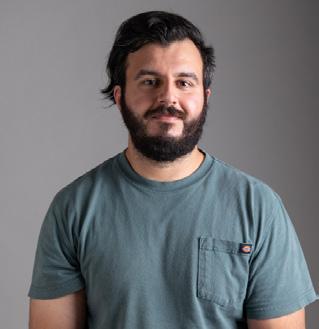

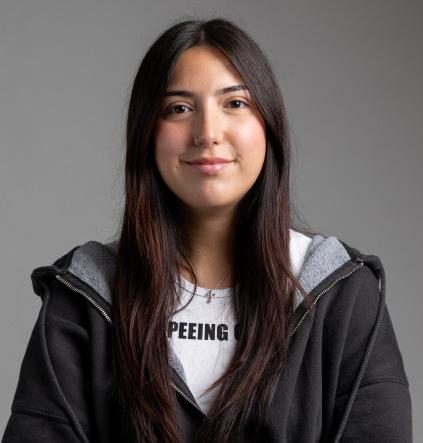



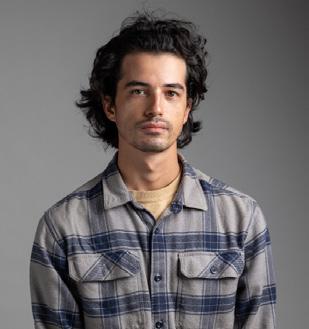











 Angelina Casolla Nathan Hitchcock Destiny Walker Ciara O’Kelley
Asiah Capponi
Giovanna Montoya Caroline Van Zandt Kamal Taj
Ximena Loeza Art Abraham Fuentes Photo
Sarah Bowen Copy
Oliver Michelsen Multimedia
Justine Brady Diversity Nadia Castro Social Media
Daniel Hernandez Design Assistant
Angelina Casolla Nathan Hitchcock Destiny Walker Ciara O’Kelley
Asiah Capponi
Giovanna Montoya Caroline Van Zandt Kamal Taj
Ximena Loeza Art Abraham Fuentes Photo
Sarah Bowen Copy
Oliver Michelsen Multimedia
Justine Brady Diversity Nadia Castro Social Media
Daniel Hernandez Design Assistant
Lynna Davis climbs at Dogpatch Boulders on Oct. 1, 2022. When she was going through a tough time in 2017, Davis sought out climbing and found it signifi cantly improved her mental health. (Tatyana Ekmekjian/ Xpress Magazine)
By Destiny WalkerLynna Davis, a pharmacy student in San Francisco, grew up not knowing anything about sports — until one day at the gym, she saw a climbing wall and it sparked her curi osity. Initially, her fear of heights made her hesitant to climb.
“I was just trying to find something to give me anything at that point,” said Davis.
Davis went through a breakup during her undergrad uate years at Cal State Long Beach that made her feel like she was in a dark hole, unable to eat or sleep.
“I was able to slowly get out of my depression, because I not only found something that I could actually do and look forward to, but also, the mental aspect of it,” said Davis.
Studies show that physical activity is important in bettering mental health. This May, a study in the National Library of Medicine found that physical activity positively impacted the moods of young adults with PTSD.
The mental and physical aspects of bouldering, com bined with the community that develops around it, has made climbing a form of therapy for some.

In a study published by BMC Psychiatry, German researchers incorporated rock climbing as a therapeutic approach into some of their psychiatric hospitals. Patients attended a bouldering psychotherapy program for eight weeks. Afterwards, researchers found depressive symptoms improved by around six points on the Beck’s Depression
Inventory, a test used to measure severity of depression.
Climbing helped Davis to overcome her fears and strengthen herself mentally. But the community she’s found has also been a game changer.
“I was in such a bad place. I didn’t really want to talk to people. But these people were so friendly that it made it easy to build a connection,” said Davis.
When climbing, there is a lot of trial and error. Boulder ing requires problem-solving, because there are many ways to achieve one route. Difficulty level, hand and foot place ment and the climber’s size are all factors that make each climber complete a route differently.
“It’s a constant challenge to figure out the routes. Each route on the wall is like a puzzle,” said Davis. “And sometimes I might fail a million times. But it’s that mental challenge that gets me to keep going back on — to try it in different ways.”
Though she has a lot on her plate, Davis prioritizes her mental health by making a goal to climb at least twice a week.
“No matter how busy and stressed I am, if I go out and take that time to go climbing, it will make me feel better and more productive,” said Davis. “It’s not an escape; it’s a necessity.”
When Claire Miller was six years old, her dad — an avid climber — took her and her sisters along with him to indoor climbing gyms in San Jose. But it was another ten years
Rock climbing is not just a fun hobby. For some, it can also help guide them through their mental health journey.
before Miller also fell in love with the sport.
“I started to like [rock climbing] really in high school because I didn’t like to do other sports,” said Miller.
Miller discovered that climbing required complete fo cus on the activity before her, allowing her to get out of her own head.
“When I first got really into climbing when I was 16, I was battling depression pretty severe ly. But I was at the gym everyday. It is good to use your body, use your brain, because it is prob lem-solving,” said Miller.
Miller now works in the climbing industry as a full-time route setter, strategizing and curat ing routes for climbers to ascend.
Climbing has also helped her to be confi dent in her own body.
“It helps me tune into my body and body confidence, trusting my strength and trusting my ability,” said Miller. “I need these strong mus cles to hold myself on the wall. I like the feeling of being strong.”
Kim Clint is originally from the Philippines, but now resides in the East Bay and works as a barista. Hip-hop used to be her outlet to relieve stress and express herself, but when she came to the United States, climbing took its place.
“When I was dating my now-husband, he got me into rock climbing,” said Clint. “At the beginning, I’m like, ‘it’s not for me, I’m too weak for this.’ But I just kind of went with him just to have this bonding, quality time with him. And then I just fell in love with it. I go rock climbing more than him now.”
Clint always climbs after work. On one particular day, she was attempting a route that she had tried multiple times before but couldn’t complete. During a break, she got a stressful text about work from her boss. It added to her frustration over failing the climbing route. But after re sponding to the text, she completed the climb.
“And it just goes to show, I’ve been holding something back in my head. I’m not pushing enough. And that situa
tion kind of pushed me,” said Clint.
Clint started seriously climbing before the pandemic at V2 and V3 grades, which are considered beginner and intermediate levels. She’s now looking to ascend a V7, an advanced level.

“It’s just, for me, an outlet of whatever you’re feeling at the moment. And the amazing thing about climbing is, it’s not a competition. You’re just competing with yourself and the wall,” said Clint.
Rock climbing has changed the way Clint approaches obstacles in her life.
“I see this similarity of climbing and having a problem in life. Like, if you’re climbing, you take a step back and look at the whole route,” said Clint “You just don’t stare at the start, you just don’t stare at the tough part of the problem. You step back, you try to figure it out from start to finish.”
Timothy Lee, a San Francisco native and occupational therapist, began climb ing at San Jose State University. Climbing was only a hobby back then, but he started taking it more seriously in 2019.

“Lifting weights was getting kind of boring, and you just kind of do the same reps over and over,” said Lee. “But with rock climbing, there’s a lot of problem solving. The people who set up problems do so in a man ner that kind of challeng es not only your body, but your mind.”
Lee enjoys the climbing community’s encouragement.
“Sometimes when I climb by myself, you know, the stoke isn’t there. It’s that stoke, and I get that hype from my climbing friends. And it can really push you past barriers that you thought you had where you thought you couldn’t reach,” said Lee.
The strong rock climbing community helps Lee cope with seasonal depression, which can make him want to climb and deal with his problems alone. But he pushes himself to engage with his climbing community. “That encouragement, and having a good time with my friends, and looking forward to something,’’ said Lee. “It’s a coping skill.”
Timothy Lee hangs from the wall, only gripping it with his hands while climbing at Dogpatch Boulders on Oct. 1, 2022. Lee directs all his attention to planning his next moves up the wall whilst simultaneously using all his strength to hold himself up. (Tatyana Ekmekjian/Xpress Magazine) Timothy Lee records his friend climbing at Dogpatch Boulders on Oct. 1, 2022. Lee encourages his friends while climbing, creating an atmosphere that fosters enthusiasm, as well as a collaboration of techniques and advice. (Tatyana Ekmekjian/Xpress Magazine)Meet the fashion focused pair dedicated to documenting the outfits of SF State’s student body.
By Oliver MichelsenFits of SFSU co-founders Breanna Miller (left) and Esperanza Vaquiz (right) pose for a portrait in Malcolm X Plaza, Sept. 15, 2022. Both second-years, the pair hopes to continue running the page with the help of new admins in the coming semesters.

SF State’s quad is filled with the sounds of students greeting friends on their way to and from class, landscap ers maintaining the plant life and music playing from any one of the speakers positioned throughout the area. But since the return to campus back in August, a new line has joined this chorus of sound.
“I made it onto Fits of SFSU!”
Fits of SFSU is an Instagram account created at the beginning of the fall semester, and it has already amassed more than 2000 followers. The account consists of pho tos taken around campus of different student and faculty outfits. About ten people exhibited in each post, all varying in their fashion style. The account’s biography boasts a simple mission statement: “Capturing the flyest students at San Francisco State.”
But who is behind the account? Second-year students Esperanza Vaquiz and Breanna Miller.
“Literally, my favorite thing to do is people-watch,” Va quiz explained. “‘I’m walking around campus one day and, in my head, I’m like, ‘Damn, they look good. He looks good. She looks good. I need to photograph these people.’ And so I literally made an Instagram with zero followers and was just was like, fuck it. It might be a flop, but who cares?”
At the beginning of the fall semester, the pair met at a social gathering for their sorority, Alpha Gamma Delta. They immediately hit it off. Despite only knowing Miller for a day, Vaquiz asked her to help with the account.
Since then, the two set up in front of Cesar Chavez Student Center and Malcolm X Plaza every Tuesday and Thursday, stopping students and faculty alike to ask if they can post a picture of their outfit on Instagram.
This isn’t necessarily a new idea. The two are not the first to start a social media account dedicated to document
(Oliver Michelsen/Xpress Magazine)ing college campus fashion. Accounts like @ucsc.fits and @ ucbfits, for UC Santa Cruz and UC Berkeley respectively, have existed for close to a year now. However, Fits of SFSU account has gained more followers than both of these ac counts combined in just two months, and consistently gets approximately four times as many likes.
“We’re from LA, so when you go there, you know, people are walking and they have all those ‘fuck off’ faces,” Miller said. “Maybe some of them have it here, but once you’re actually like ‘Can I take a picture?’ They’re like ‘Hell yeah!’ and [we] just start talking. That’s the one part about San Francisco State that’s definitely different from other col leges: people are actually open to getting to know people.”
For two years, the SF State campus was left quieter than ever by the pandemic and the subsequent turn to hy brid instruction. But now, the quad fills every day with stu dents wearing everything from 6-inch platforms to Birken stocks. This surge of people from the return to in-person classes is likely to thank for the page’s quick growth. Most posts have more than 400 likes, and the comment section is filled with students tagging their friends featured in the post.

Even with their recent growth, the pair’s mission for

the page has stayed the same. Miller and Vaquiz recalled an early comment the page received requesting that they be weary not to discriminate against people or their out fits based on gender, class, race or sexual orientation.
“Everyone has a different sense of fashion style. So I want all of it, as much as I can, to be included into that, so that they feel seen,” Vaquiz said. “We really took that and were like ‘for sure.’”
The pair behind the page show no signs of stopping. Since hitting 2000 followers, they have brought on ad ditional admins and started holding themed events. For their most recent milestone, the page had students dawn their best Y2K-inspired outfits, a fashion trend focused on encapsulating the vibe of the mid to early 2000s.
Outside of the Instagram page, the two hope to or ganize a flea market style swap meet to make a diverse range of clothing more accessible to students.

 Breanna Miller captures a photo of an SF State student passing through the Quad to post on the Fits of SFSU instagram account. She along with co-founder Esperanza Vaquiz both said they want to include as many style types on the account as possible. (Oliver Michelsen/ Xpress Magazine)
Fits of SFSU posts a wide variety of student and faculty outfits. (Photos courtesy of Donovan Martel, Fits of SFSU Instagram page/Xpress Magazine)
Breanna Miller captures a photo of an SF State student passing through the Quad to post on the Fits of SFSU instagram account. She along with co-founder Esperanza Vaquiz both said they want to include as many style types on the account as possible. (Oliver Michelsen/ Xpress Magazine)
Fits of SFSU posts a wide variety of student and faculty outfits. (Photos courtesy of Donovan Martel, Fits of SFSU Instagram page/Xpress Magazine)

 By Angelina Casolla
By Angelina Casolla
SF State Alumnus turned rapper, filmmaker and trailblazer.Payton in the old KSFS radio room. Photo courtesy of Michael Payton.
In the summer of 2002, Ja Rule’s “Down 4 U,” the second single off the compilation album “Irv Gotti Presents: The Inc.,” was number six on the Billboard Hot 100. Fascinated by its sound, Michael J. Payton assembled his cousins to record their own compilation album — writing songs and producing beats to parody the album.
Payton was always a fan of Ja Rule, but he grew more intrigued with the man behind the music: Irv Gotti, hip-hop mastermind and CEO of Murder Inc. Records. Sitting in his NYU dorm room 16 years later, Payton took out his laptop, inspired to tell the story of the world’s most notorious record label that seemingly vanished. He never imagined it would lead to a job opportunity that would one day land his work on national television.
“I was always fascinated by Irv’s story and by the story of Murder Inc., and the label just kind of disappeared. They were burning hot and then they had 50 Cent, then they had a federal case, and they just kind of went away,” Payton said.
Murder Inc. became the world’s most notorious record label in the early 2000’s with a slew of chart-topping hits. La bel artists like Ja Rule and Ashanti dominated the airwaves. Gotti, the genius behind it all, earned a spot in the Guinness Book of World Records for the most consecutive weeks at number one by the same producer. Gotti also helped culti vate the careers of artists like Jay-Z and DMX.
Oakland native and SF State Alum Michael J. Payton is a rapper turned filmmaker and social entrepreneur. His aspirations to one day become a rapper started when he was a kid and put him into this space of creativity and expression that he remains in today. The summer of 2002, when Payton and his cousins made their faux compilation album, gave him his first taste of what it was like to make records.
“It kind of sent me down the path of being an artist myself — being a producer, and then eventually, way later down the line, I would shoot music videos for myself and other artists around SF State,” Payton said.
Payton graduated from SF State in 2015. His time at the university was funded by a scholarship through rapper JayZ’s Shawn Carter Foundation, which eventually came full circle when Payton interviewed Jay-Z for the official Murder Inc. documentary.
He majored in Broadcast and Electronic Communica tion Arts, and eventually started shooting music videos for himself and other artists, such as local San Francisco legend and rapper San Quinn, and fellow SF State alum Voris Forte. These backyard music videos gradually turned into YouTube documentaries, setting him on his path towards filmmaking.
“I didn’t set out to be a filmmaker, but it just kind of hap pened organically,” Payton said.

SF State played a big role in Payton’s development as an
 Payton became a BSU coordinator. Photo courtesy of Michael Payton.
Payton discussing his Hillary Clinton documentary. Photo courtesy of Michael Payton.
Payton became a BSU coordinator. Photo courtesy of Michael Payton.
Payton discussing his Hillary Clinton documentary. Photo courtesy of Michael Payton.
artist and creative. One of his last musical proj ects was an EP titled“19th & Holloway,” in which he rapped about his experiences at SF State. Pay ton also worked on the campus radio station during his time on campus as a promotions manager and eventually worked his way up to general manager.
Jeff Jacoby, faculty advisor of SF State radio station KSFS, remembers Payton as smart, in tellectually-oriented, kind and genuinely caring about those around him. Even as a young under grad, Payton turned heads with his work. Jacoby remembers one of Payton’s submissions to BECA fest, the department’s end of the year showcase, in particular.
“Michael submitted a song to the music production category one year that was so full of expletives that he enraged some of the judges,” Jacoby joked. “I don’t remember if he won an award or not, but I remember that.”
Payton hosted large events such as “Chaos in the Depot,” where he brought different artists like rapper Waka Flocka Flame to campus.
“It was like a mini-Coachella or miniature Outside Lands,” Payton said. “We would get rock bands and hip-hop bands and everyone together, and just put this mashing of genres together, and it was just a great time.”
In 2018, while working on his masters at NYU, Payton wrote, edited and narrated an unofficial Murder Inc. documentary and posted it on You Tube. It slowly picked up speed before it caught the attention of the former record label’s CEO, Gotti. Today, the unofficial documentary has over 600,000 views on YouTube.
Months after posting the unofficial documen tary, Payton’s world came crashing down when his mother passed away.
The very same day he laid his mother to rest, Gotti reached out to Payton. Payton thought Gotti must be contacting him to take the documentary off YouTube. But instead, Gotti offered Payton a job opportunity that would take his career to new heights.
Impressed by his storytelling skills, Gotti hand-picked Payton to direct the official Murder Inc. documentary. Payton was given complete creative control and interviewed icons such as Nas, Jay-Z, Ja Rule and Fat Joe to help tell the story of the record label’s rise and fall from greatness. “The Murder Inc Story” is a five-part documentary series that was released on BET in August of 2022.
In addition to being a hip-hop enthusiast, Payton is a self-proclaimed political junkie, always looking to “blend hip-hop culture and pop culture with poli cy making and policymakers and changemakers.”
He landed an executive fellowship in former Gov. Jerry Brown’s office, allowing him to bridge his two passions.
“I see the younger generation and people of color really disconnected from the world of deci sion-making,” Payton said. “We have a bunch of folks here making decisions on our behalf. But we don’t really see the connection, and that we can directly influence that. And the one thing that brings everyone together is music.”
Inspired by the success of promoting shows on campus, Payton started his own production company, M Payton Multimedia Productions. The precursor to his current company, CSUITEMU SIC, “a company dedicated to bridging artistic expression with business, policy, and communi ty.” Within CSUITEMUSIC, Payton continues to combine both his love for hip-hop and politics.
“The celebrity thing is really kind of a Trojan horse for me,” said Payton. “I’ve done all this work trying so hard to get into the entertainment space, so that I can come back into the social justice space with a little more clout.”
Payton is currently working on a documen tary about the evolution of women’s agency in hip-hop over the last 50 years, as well as another documentary about the 50th anniversary of the hip-hop genre.
“Working with celebrities or working with en tertainers makes it easier to amplify my message,” Payton said. “Working with a team like Jay’s team, which are very much focused on the social justice space and working in the community space as well. So it’s almost like the perfect synergy.”
“We have a bunch of folks here making decisions on our behalf...the one thing that brings everyone together is music.”

 Payton being interviewed in the old KSFS radio room. Photo courtesy of Michael Payton.
Payton performing in the Annex at SF State. Photo courtesy of Michael Payton.
Payton being interviewed in the old KSFS radio room. Photo courtesy of Michael Payton.
Payton performing in the Annex at SF State. Photo courtesy of Michael Payton.

For a book lover, nothing is quite as delightful as stepping into a bookstore. There’s the smell of hundreds of new books, the sound of crisp pages being flipped through and fresh spines being cracked, along with the comforting notion that everyone in the building is seeking a new world to escape to in between the covers. There’s something solacing about a cozy book shop to a bibliophile, and it is exactly that feeling that has kept small-owned bookstores in business.
According to the Census Bureau’s County Business Pat terns, the number of brick-and-mortar bookstores decreased from 12,151 in 1998 to 6,045 in 2019 across the country. Al though these numbers look grim on paper, it seems the book industry and many local bookstores are thriving, with print sales up 8.2% while e-book and audiobook sales have grown over 12%, according to a research summary by Zippia.
To Potrero Hill staple Christopher’s Books, selling books is a labor of love. The store is located on the corner of 18th St. and Missouri St., in a building that used to be a pharma cy back in the 1920s. Open since July of 1991, this quaint bookshop brimming with history has endured three decades of turbulence in the book business.
“First it was chains,” said the sole owner of Christopher’s Books, Tee Minot. “Then it was Amazon. Then it was e-books. Then it’s just online shopping in general.”
Despite the rise in competition due to Amazon’s e-books growing popularity, not to mention being forced to close during the pandemic, some small-owned bookstores in San Francisco have survived against all odds.

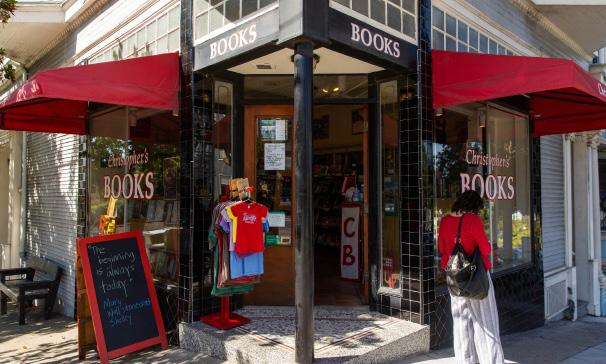
In the past, small-owned bookstores only had Barnes and Noble to compete with. Yet Barnes and Noble stuck around
long enough to turn from a villain to an underdog to root for. Mostly thanks to Amazon– Barnes and Noble’s revenue had been on the yearly decline since 2012 up until 2019, despite being the largest book retailer in the United States. If the largest bookseller in the country was struggling, it’s a true marvel that so many local bookshops have been able to keep the lights on.
Before the introduction of Amazon and e-books, readers would have to either leave their house and go to a bookstore or order their book online and wait a couple of days for it. Thanks to online retailers such as Kindle, all one has to do is press a few buttons on their phones, tablets or computers, and the book is theirs to be read within minutes.
“I prefer e-books over physical copies,” said avid reader Tarazjanae Cooksey. “It’s just a lot easier to scroll on my phone through books. I don’t have to wait for a book to come in or go to the store, it’s just all there at my convenience. Also I like to be able to change the brightness and darkness of my books and I can make the text bigger.”
It can seem almost impossible to compete with the easy accessibility of these retailers, but fortunately that is not something Minot wants to achieve with her shop. Instead, she focuses her attention on making each customer’s trip to Christopher’s Books one to remember.
“I can’t compete on a price point with Amazon,” said Mi not. “There’s just no way I could do it. But I can compete by providing an experience for someone. And that’s what we try to do. I have to think that that’s something they’re willing to pay for. I just try to give someone the experience that they’re not going to get online.”
Minot touched on something that Amazon and online retail ers can’t compete with: personality. The Booksmith on Haight St. has no shortage of personality with its art-filled walls, mood lighting and gracious staff.
How local bookstores in San Francisco are thriving despite the ever growing presence of E-booksAn individual stands outside Christopher’s Books in Potrero Hill on Sept. 27, 2022. Formerly a pharmacy, Christopher’s Books has been in business since 1991. (Juliana Yamada/Xpress Magazine) Sophia Ramirez (left) and Trinidad Gallegos (right) browse through books at The Booksmith in Haight Ashbury on Oct. 7, 2022. (Juliana Yamada/Xpress Magazine)
“We decided years ago that we would focus on doing things that Amazon can’t do well,” said Booksmith’s manager and lead book buyer Camden Avery. “Amazon is not great at mak ing recommendations for what people are going to fall in love with. It’s not great at hosting author events and community gatherings. So we kind of lean on that, we kind of lean on our personality, on our love of what we do and trust that will take care of it.”
Avery mentioned another superpower, recommendations. This seems to be able to give local bookstores an edge over the online competition. In most small-owned, local book stores nowadays, there are dozens, maybe even hundreds of handwritten notes that recommend and give a brief summa ry of whatever book it’s attached to. They’re almost like little love letters to future readers that tell them exactly what’s to love about the book. Most of these recommendations are made by the staff and add to the amiability and warmth of a small bookstore.
Minot and Avery also saw a rise in sales in 2020 after the murder of George Floyd and the boom in the Black Lives Mat ter Movement. Both booksellers hypothesize that in support of the movement, readers all over the city looked to educate themselves and learn more about the fight for Black lives, which proved to be true.


According to Forbes, there was a 6,800% jump in sales of the top books about race after the recording of Floyd’s murder went viral. For example, White Fragility: Why It’s So Hard For White People To Talk About Racism by Robin DiAn gelo saw a 2264% jump in sales in just two months. The book went from 18,492 print copies in March and April to 437,289 in June.

Nowadays, it seems to be almost impossible to succeed without the help of social media. Despite being thought of as the death of books as we know it, social media and the inter net have actually proven to have a major role in the prosperi ty of book sales lately.
TikTok, the sixth most popular form of social media in the world with over 1 billion monthly active users, has coined the hashtag #BookTok — which features viral videos where people recommend books, talk about their favorite tropes and authors and even post fan made art. This hashtag has become a force in the book world, elevating years-old books to bestsellers seemingly overnight.
 Tee Minot gestures to old photos on the walls in the store during an interview with Xpress Magazine on Sept. 27, 2022. Minot is the sole owner of Christopher’s Books in Potrero Hill. (Juliana Yamada/Xpress Magazine)
Camden Avery, manager and lead book-buyer of The Booksmith in Haight Ashbury sits for a portrait inside the store on Oct. 7, 2022. (Juliana Yamada/Xpress Magazine)
Staff recommendations fill the shelves inside The Booksmith in Haight Ashbury on Oct. 7, 2022. (Juliana Yamada/Xpress Magazine)
Tee Minot gestures to old photos on the walls in the store during an interview with Xpress Magazine on Sept. 27, 2022. Minot is the sole owner of Christopher’s Books in Potrero Hill. (Juliana Yamada/Xpress Magazine)
Camden Avery, manager and lead book-buyer of The Booksmith in Haight Ashbury sits for a portrait inside the store on Oct. 7, 2022. (Juliana Yamada/Xpress Magazine)
Staff recommendations fill the shelves inside The Booksmith in Haight Ashbury on Oct. 7, 2022. (Juliana Yamada/Xpress Magazine)
“A bunch of our booksellers are on TikTok,” said Avery. “We’ve definitely seen a lot of book trends in sales driven by conversations happening on there.”
Another San Francisco bookstore, Folio Books in Noe Valley, has seen the power that TikTok holds and has capitalized on it. “We are definitely familiar with TikTok and #BookTok,” said Martha Dietzel, co-owner of Folio Books in Noe Valley. “We try to keep up with all book news and reviews, no matter the source, so we definitely pay attention to what is trending on #BookTok. We have seen more people coming in for specific books because of TikTok, especially more high school students.”

“We see trends come and go in terms of what types of books are selling,” said Dietzel. “In recent years we have grown our sales in graphic novels, romance, young adult and science fiction/fantasy sections. This is due partially to national trends like #BookTok in addition to those sections all being near and dear to us and our staff.”
Minot of Christopher’s Books said they even had to add an entire section of their store dedicated to romance, something she believes to be thanks to TikTok. Avid romance reader Kiara Rios, is a proud member of #BookTok and has even joined three book club groups on Facebook.
“[The Facebook pages] are so cool,” said Rios. “I’ve seen people post about what they would look for in a book and then people just comment all these crazy recommendations. And through TikTok, I’ve found so many books. I think I’ve read more books this year than I have in my life.”
Despite the internet depleting book sales in the past, it seems it has begun to redeem itself by helping drive younger, tech-sav vy audiences to their local bookstores. These community-based bookstores have been here long before the rise of Amazon and e-books, and it’s up to said community to make sure they stay around long after by choosing character over convenience.
“we kind of lean on our personality, on our love of what we do and trust that will take care of it.”A woman looks inside Folio Books in Noe Valley on Sept. 27, 2022. (Juliana Yamada / Xpress Magazine)

 Robby Bancroft walks down the stairs of a Pacifica, Calif. house on Oct. 6, 2022. Robby doesn’t live far away, but this particular neighborhood is that of his competitor, Christine Boles. (Joshua Carter/Xpress Magazine)
Robby Bancroft walks down the stairs of a Pacifica, Calif. house on Oct. 6, 2022. Robby doesn’t live far away, but this particular neighborhood is that of his competitor, Christine Boles. (Joshua Carter/Xpress Magazine)
In April 2022, the band Obsolete Man played for a surging crowd of punks at Church of The Buzzard, an old warehouse in Oakland. The show had everything — from the smell of pungent body odor to old punks in camouflage shorts, moshing violently. Obsolete Man’s lead singer, Robby Bancroft, ended their song “Violence” by asking the crowd to help him surf all the way to their merch table.
On a night like this, it might be difficult to imagine Bancroft announcing his candidacy as a supervisor for the city of Pacifica — the coastal town of 40,000 people just 15 minutes south of SF State.
“When Robby told me he was running for supervisor, I didn’t even laugh,” Devan Bleyle, Obsolete Man’s bassist, said. “I mean, it does kind of make sense. He’s always doing community stuff. If you go to Pacifica, pretty much everyone knows that dude. I graduated five or six years after him, and even I knew who he was before I met him.”
Bancroft serves on the Board of Directors for Pacificans Care, a nonprofit helping provide core social services to the community. Bancroft has also worked as the communication director for the Pacifica Resource Center, one of the social services Pacificans Care provides. The Resource Center provides essential care to Pacif icans — ranging from rent payments to food banks and clothing drives. He previously worked with Chegg and traveled across the country getting people to vote.

Bancroft’s campaign officially kicked off on September 24 at Fogfest, a local celebration highlighting Pacifica citizens. It was the ideal time for candidates to make their first appearance on the political stage with dozens of vendors, hundreds of city employees and thousands of residents and visitors crowding the streets in a merry atmosphere of community appreciation.
Christine Boles, his competitor, walked through Fogfest alongside en vironmentalists and teachers. Boles, an architect and community advo cate, took a more orthodox approach, smiling and waving as she walked through the street as her supporters held up signs in support.
Bancroft decided to take a more confrontational approach. On a white moped, the political punk drowned out the other supervisors with his horn, speeding through the crowd to their floats to give out bags of candy and “Robby 2022” buttons to locals. Those who stayed ahead of Bancroft’s horn found themselves equally drowned out by a legion of bike-riding sup porters ranging from young children to tattooed waste workers, all shout ing “ROBBY! ROBBY!” at the top of their lungs.
While his approach is unconventional, Bancroft says it’s time for the framework of professionalism to change.
“Politicians should be people.” Bancroft said. “We’re representing peo ple, so why are we afraid to be people? I’m not ashamed of who I am. I’m proud of my band, proud of my community, proud of my Filipino heritage.
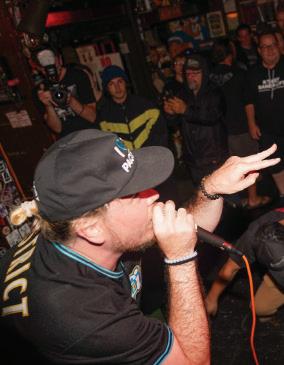
Devan Bleyle plays bass after a night of playing with his band, Obsolete Man, in Pacifica, Calif.’s Winter’s Tavern on Sept. 24, 2022. “There’ve been times when we were upset because it felt like nobody was moshing at our shows,” Bleyle said, “but they told us it’s because we’re such a fucking spectacle. (Joshua Carter/Xpress Magazine)

At the end of Fogfest, Bancroft met his band, Obso lete Man, for a show down the street at Winter’s Tavern, a local rough-and-tough, live music bar. Supporters who spent the day questioning Bancroft on housing policies and credentials stared on in admiration, shock or confu sion as their potential supervisor climbed on top of the bar to scream philosophical lyrics about community and hopelessness.
When Kevin Burleigh’s isn’t drumming for his hard core band Soul Pain, he creates photo and video content for Bancroft’s campaign. Burleigh originally started off filming shows archive-style and met Bancroft while film ing an Obsolete Man set. He feels Bancroft’s transition into politics was natural.
“We used to joke that one day he’d be mayor,” Burleigh said. “We’d walk around Pacifica all day and he would always be stopping to talk to everyone.”
While Bancroft’s over-the-top stage personality bleeds over into his political canvassing, he says it’s the logisti cal part of the job that prepared him for office the most.
“Some of the benefits of being a vocalist are kind of obvious,” Bancroft said, power-walking up a steep hill on Monterey Road. “But it’s the logistics that have always benefited me the most. The DIY scene is a pretty signif icant place for grassroots movements and fundraising, and pretty much every band nowadays has to be good at marketing to some degree. I’m lucky the guys in my band know about the scene and nerd out over hardcore and powerviolence, because I’ve always been more of a logistics guy.”
Pacifica has a $2.7 deficit from a decade’s worth of lawsuits and a handful of mandates, including a recent law mandating district supervisor elections. Bancroft says his opponents have pointed to his inexperience, but he argues his age represents the grassroots capa bility of his platform.
“I know they say I’m inexperienced, crazy, young, whatever,” says Bancroft. “The community pays attention to the fact that I’ve been fundraising in this community before a lot of residents even lived here. They don’t think you can make a change unless you’re older, or have a ton of money, but I’m here to show that all you need is community.”
Bancroft’s primary goals as supervisor are to raise funding and create contracts to increase mental health services in lower-income parts of Pacifica. He also wants to build more affordable housing, a promise San Fran cisco’s supervisors often mimic in their campaigns. But while San Francisco may have municipal political systems to emulate, it can’t compete with Pacifica’s small-town level of familiarity.
Bancroft says his struggles and experience as a small business owner, plus his track record in communi ty service, give him an appeal to the working class. As he canvasses through the community, he makes sure to mention how his father’s house foreclosed the same year rival candidate Boles bought a lot in his neighborhood.
“My greatest strength is that I know the heartbeat of this place, and genuinely care about the people in this town. When I talk to locals, I always tell them how I lost my house and that I’m still fighting for an affordable place to live in my own community. When someone is struggling alongside you, someone born and raised in the same community, it makes it more personal.”
Recent lawsuits from the ACLU targeting the city’s aggressive stance towards RV parking and district repre sentation have only added to the city’s deficit, and both candidates promise similar solutions for finance and equity. With eminent crises looming, the Pacifica resi dents head to the polls on November 8 to vote for either a pragmatic architect with a focus on affordable housing and the environment or a local with a DIY influence and a long rap sheet of handling budgets.
“We used to joke that one day he’d be mayor. We’d walk around Pacifica all day and he would always be stopping to talk to everyone.”

On an early Saturday morning, thick fog blanketed Daly City as Mayor Rod Daus-Magbual got ready to start his day.

First on the agenda was a literature drop around the neighborhood — a solid hour of walking up and down hills armed with fliers and door hangers and telling constituents why they should reelect him.
Dr. Arlene Daus-Magbual, a professor of Asian Ameri can studies at SF State and Mayor Daus-Magbual’s wife of 14 years, says her husband has always been a leader. She recalled how he was the president of various clubs through out the time she’s known him — from when they met in high school, all the way to now, when he’s the current executive di rector for Pinay/Pinoy Educational Partnerships (PEP). PEP is an educational program founded by Dr. Allyson Tintiang co-Cubales and her students at SFSU in 2001.
Despite what seems to be a natural progression for some one as active in the community as he is, Mayor Daus-Magbual never expected to run for public office, though he did have every intention to help his community.
“I knew that I was always going to serve youth. I knew it’s always going to be around Asian American, Filipino Amer ican youth. I knew it was going to be around ethnic studies,” said Mayor Daus-Magbual. “If you told me in college, ‘Hey, you’re going to be running for elected office,’ I’ll be like, yeah right, you’re trippin’.”
He graduated from UC Riverside in 2000 with a degree in Liberal Studies and received his Masters in Asian American Studies from SF State in 2004. He earned his Educational Doctorate from the University of San Francisco in 2010.
For the past 20 years, Mayor Daus-Magbual has been an educator. He started out as a teacher in PEP, teaching Filipino American Studies in various schools across the Bay Area. He also was an adjunct professor at several Northern California colleges including SF State, UC Davis, Sonoma State Univer sity, City College of SF, and others. He finally landed a ten ure-track position as an Ethnic Studies professor at Skyline College.
“That’s also what gives me a different position when it comes to this role as a politician, is the grind. Like, I fucking grinded for hella years with a family and two young kids try ing to chase that dream,” said Mayor Daus-Magbual.
While making the rounds as an educator, Mayor Daus-Magbual was appointed to the Daly City Library Board of Trustees in 2014 by then-councilmember and current Daly City Vice Mayor Raymond Buenaventura. Mayor Daus-Mag bual then served on the Planning Commision in 2017, until he finally ran for and was elected to city council in 2018.
Mayor Rod Daus-Magbual walks down the stairs of a constituent’s home after plac ing a door hanger for his reelection cam paign in Daly City on Oct. 8, 2022. (Miguel Francesco Carrion / Xpress Magazine)TOP: Mayor Rod Daus-Magbual listens during the public com ment portion of the Daly City city council meeting on Oct. 10, 2022. (Miguel Francesco Carrion / Xpress Magazine)


BOTTOM: Mayor Rod Daus-Magbual spends time with his son and daughter, Razón and Amianan (L-R), after his morning literature drop before he heads to the Kasayahan Sa Daly City event on Oct. 8, 2022. (Miguel Francesco Carrion / Xpress Magazine)
Mayor Daus-Magbual hopes to use his network as an educator and his position as an elected official to benefit the community. He claims that being in the unique position of a professor and councilmember gives him opportunities to support programs such as a proposed Filipino youth center or the Filipino Mental Health Initiative, making connections from the community to city hall.
There were many reasons and sources of inspiration for Mayor Daus-Magbual’s decision to run for office, though he said that the kicker was a panel discussion he took part in with the late Dr. Dawn Mabalon, a Filipina American historian and professor at SF State.


During the panel discussion, Mayor Daus-Magbual remembered that Dr. Mabalon said “we got to be part of the process before times of protest,” as she talked about the destruction of Little Manila in Stockton, California. He cited that as the pivotal moment that fueled his first campaign.
“What we’ve learned as we built this teaching profession for the past 20 years is that the classroom is not limited to the schoolhouse, but the class room is everywhere you go,” said Dr. Daus-Magbual. “So you’re a teacher anywhere, and everywhere you go, regardless of the position that you have.”
“Making history is hard. And that’s what I’m here to do. You know, be cause history is not just in the past, but it’s also what you can create so that the next generation can inherit a better world,” said Mayor Daus-Magbual.
Within any retail store, brand-new pieces of clothing sit on racks, waiting to be worn and styled for years to come. But for many of these clothes, this won’t be the case.
A study commissioned by Barnardo’s, a British charity, revealed that articles of clothing are only worn an average of seven times before being forgotten or tossed out. In 2018, the US Environmental Protection Agency estimated that about 15% of all post-consumer textile waste gets recycled, with most of the remaining 85% ending up in landfills.
This is due, in part, to the growing fast fashion industry. Fast fashion is a branch of the fashion industry that imitates runway trends, quickly moving from design to production to retail. These garments are sold to consumers at an extreme ly low cost, after being mass-produced at an even lower cost. Companies such as Zara, H&M, Forever 21 and Fashion Nova are just a few notorious fast fashion retailers.
“They’re in business to be successful, and no one knocks that,” said Stephanie Currie, professor of apparel design and merchandising at SF State. “The problem is that they are overwhelming the consumer with product. Therefore, we have a massive amount of waste.”


According to the University of Alabama Institute for Hu

man Rights Blog, manufacturers utilize low-quality textiles and exploitative labor to quickly distribute products at a cheap, affordable price. This allows them to introduce new collections at a rapid pace.

Traditionally, apparel production was limited to the four seasons. Designers, brands and companies would release seasonal collections of coordinated garments to be mixed and matched. However, brands now produce designs and garments weekly, providing consumers more options but also forcing trends out of style at a faster rate and leaving copious amounts of clothing in landfills. This is overproduction — when corporations produce more products than they sell.
“Overall, the issues with fast fashion have to do with consumption,” said Currie. “The fact that it exists is not as much of a problem as the fact that it is so inexpensive and so over-consumed. It’s really driven by the consumer.”
Combatting unsustainable fashion is a difficult task, but not impossible. Educating consumers is essential to slowing fast fashion’s growing power in the industry.
There are also alternatives that benefit the environment, such as upcycling.
Upcycling is the process of turning textiles or pre-loved
Ivy Chan sews into a gray shirt that will be later upcycled into a new set of clothing. They will later be sold in ISSO in the Mission at 3608 19th St. Oct. 7, 2022. (Abraham Fuentes/Xpress Magaclothing into something new. Stores like Isso, a San Francisco-based boutique, specialize in producing upcycled clothing.


Shopping sustainably can be somewhat of a culture shock for someone used to fast fashion and its cheaper price tag. Marie Biscar ra, co-owner and creative director of Isso, explained how she and her business partner deal with people questioning their prices.
“I have to just break it down for them,” said Biscarra. “This is my business. I am a small business. I hunt for this item, I clean this item, I cut this item, I sew this item, and now it’s here, ready for you.’”
The production of Isso’s upcycled goods takes much longer than fast fashion. Instead of producing hundreds of thousands of gar ments at once, the creative minds at Isso make about 20 unique pieces per collection.
At Isso, plain old denim jackets are turned into works of art with embroidered jack-o’-lanterns, witches and bats. Basic thrift-store polos are turned into stylish crop tops, and drab granny-sweaters are transformed into winter statement pieces.
Joanna Patterson, an apparel design and merchandising major at SF State, said she noticed the problems with fast fashion as she got older. This awareness, combined with being unable to afford more sustainable brands, made her want to learn how to sew.
“While I’m here [at SF State], I’m learning the steps to make my clothes a little bit more sustainable,” said Patterson. “As well as learning to love the clothes I have, and not feel pressured with all those TikTok trends with fashion right now.”
While not a new concept, fast fashion has been in hyperdrive over the past few years, primarily due to the rapid cycle of social media trends.
“I’ve seen so many TikTok videos of people buying hundreds of dollars worth of Shein,” said Akari Yu, creator of jewelry brand

Over the past few years, Shein has become one of the largest online fast fashion brands in the world. They provide cheap garments — both quality and price-wise — with new designs hitting their page daily.
Shein’s prices start at $0.99, and range from random gadgets to leather jackets and fur coats. As tempting as this sounds, they are also infamous for their terrible manufacturing standards.
Even if people donate their used Shein clothes, the items are often made with such low-quality fabric that they are difficult to recycle.
“There’s such a limited amount of apparel and fabric that can be re cycled,” said Currie. “The problem is that the materials themselves are fairly weak, inexpensive and don’t hold up to wear and laundering.”
Pure-fiber textiles, such as 100% cotton, silk or wool, are fully recyclable. However, blended fabrics, such as poly-cotton blends, are more difficult to recycle. The difference between cotton and polyester is like grass and turf. One material is natural; the other is synthetic. In order to recycle blends, the two or more tightly bonded fibers must somehow be untangled and separated.
Even with today’s technology, there aren’t many ways to do this. Pro cesses that do exist are fairly new. Chemical textile recycling uses chem icals to separate the fibers in blended fabrics, while mechanical textile recycling shreds fabric, tearing it apart to separate individual fibers.
“In the long run, it’s absolutely not sustainable,” said Currie. “They’re going to run out of raw materials, because there’s nothing you can do with the end product. Once you’ve used it, that’s it.”
Spending money on curated or high-end fashion won’t get you hundreds of garments at once like fast fashion. But investing in more sustainable brands is beneficial to your wardrobe, the environment and small businesses.
Ivy Chan (left) and Marie Biscarra (right) stand outside of their shop ISSO in the Mission at 3608 19th St. on Oct. 7, 2022. They founded the shop in 2007 with the plans of having a shop dedicated to local products. (Abraham Fuentes/Xpress Magazine) A set of shirts and skirts from the summer season hangs in ISSO in the Mission at 3608 19th St. Oct 7, 2022. The set was upcycled from a polo shirt by ISSO. (Abraham Fuentes/XpressIf someone makes the short walk from SF State to Stonestown Galleria, their view might be blocked by what seems like a sun-bleached wall stretching down either end of Winston Drive. The sound of passing cars reverberates off of the peeling stark white paint of their aluminum exteriors. What some may perceive as a wall is actually bumperto-bumper RVs that twist and scale the entirety of Winston Drive.
For many years, Winston Drive has been an unofficial parking area for the temporarily unhoused and their RVs, but in recent years these RVs have solidified themselves as a permanent landmark of the area. RVs now spill onto sur rounding streets such as Lake Merced Boulevard and Buck ingham Way, both of which are used by students to commute to school. However, as the street’s population increases, so do the complaints of their presence.
“We’re here because we need to be here,” Edith Alcaraz, an RV resident, said. “I had my job back in the days before the pandemic, but a lot of us lost our jobs and everything else…what we have is what you see.” Alcaraz currently lives on Lake Merced Boulevard with her 15-year-old son, who she hopes to enroll at neighboring Lowell High School.
The US Department of Education found that during the 2018-2019 school year, nearly 271,528 public school students experienced homelessness. In July 2020, 31.3 million, during the height of the pandemic, people reported that they had been unable to work at some point in the last four weeks because their employer closed or lost business due to the pandemic.

Recently the city of San Francisco and SF State have been in talks about converting Lot 25, an underused univer sity parking lot, into an RV parking area. The lot, located behind Lowell High School’s football field on Winston Drive, would need to be provided with utilities such as water, elec tricity and sewage to accommodate the RVs. However, both parties are at a stand still with the project’s location and timeline.
It is quite pricey to set up infrastructure for a live-in lot. To be able to provide a space that was never intended for that purpose is no easy task — especially if the site exists for only a couple years. “We’re hoping for two years allotment, and then people can park there and hopefully move on,” said Fieber.
Those familiar with SF State know that parking can be somewhat of a commodity. Students often end up circling the streets surrounding campus like a mechanical shark. With the demand for parking only increasing, students and residents feel that the RVs would take up prime real estate.
“It’s kinda weird that they’re parked there on the street, and parking is terrible here as it is,” said Ibrahim Twist. Twist, who is in his fourth year at SF State, struggles to find parking around campus. When asked about the potential housing site for individuals parked along Winston Drive, he agrees that an RV lot would be a great solution to address the crowded streets.
This is only one of the locations that the city is consid ering for the alternative long-term street parking according to President Mahoney’s office. “We’re working to assess the
A sign posted in the window of an RV parked along Lake Merced Blvd. stands as a reminder to those that may forget there are people who live here. Residents often deal with breakins and belongings being stolen, such as generators or other personal effects. (Kamal Taj/Xpress Magazine)The city of San Francisco and SF State consider a possible solution to long-standing RV parking issues
future needs of the campus community,” said Robert King, Director of Communications for the Office of the President.
As SF State works to gather more information on what the proposal would mean for their campus, their main focus is on whether or not the potential lot will interfere with the ability to accommodate students’ needs.

Neighbors around the area of Winston Drive have filed complaints about the RVs. “We’ve been looking at finding a location for two and a half to three years, and many of the residents on Winston have been there for nearly that long,” said Jennifer Fieber, legislative aide to Supervisor Melgar, whose district includes SF State and the neighboring com munity. “It’s been the most stable housing they’ve ever had.”
Ariana Montoya, a local resident, is familiar with the RVs parked between Lowell High School and the university. “It seems like it would definitely be helpful. It seems like there’s a lot of people living there, so I think any kind of provided housing could help,” said Montoya. “I’ve seen kids playing around there and I think a safer designated area would be helpful.”
Kyle Azevedo is 25 years old and from Rio de Janeiro, Brazil. He has lived on Winston Drive since April 2020. “Nobody wants to live on the streets. This is not a choice — this is something I have to do,” said Azevedo. “I used to live in Foster City, I shared a 3-bedroom house with 5 people, but because of COVID we can’t afford rent,” he said.

It is quite pricey to set up infrastructure for a live-in lot. To be able to provide a space that was never intended for that purpose is no easy task — especially if the site exists for only a couple years. “We’re hoping for two years allotment, and then people can park there and hopefully move on,” said Fieber.
 Kyle Azevedo, a resident of the RV parked on Winston Drive, sits in the doorway of his RV holding his cat, Luma. He became unhoused during the pandemic because of increasing rent costs (Abraham Fuentes / Xpress Magazine)
Luma (right), Freddie (center) and Poke (right), Kyle Azevedo’s cats, sit at the entrance of Azevedo’s RV (Abraham Fuentes/Xpress Magazine)
Lot 25’s sign posted in front of the parking lot entrance on Winston Drive. An RV pictured in the background sits parked near the back of SF State dorms located off Buckingham Way. (Kamal Taj/Xpress Magazine)
Kyle Azevedo, a resident of the RV parked on Winston Drive, sits in the doorway of his RV holding his cat, Luma. He became unhoused during the pandemic because of increasing rent costs (Abraham Fuentes / Xpress Magazine)
Luma (right), Freddie (center) and Poke (right), Kyle Azevedo’s cats, sit at the entrance of Azevedo’s RV (Abraham Fuentes/Xpress Magazine)
Lot 25’s sign posted in front of the parking lot entrance on Winston Drive. An RV pictured in the background sits parked near the back of SF State dorms located off Buckingham Way. (Kamal Taj/Xpress Magazine)
 ByEianGil
ByEianGil
The following AI image creations were all created using MidJourney AI. The prompts inputted into the AI were based on general descriptions of the artwork made by Norkeliunas and Mir zamani, who have both agreed to have their artwork compared to their AI counterparts. These comparisons of real vs. AI artwork shows just how low the barrier of entry is for using some of these AI models, and gives readers an opportunity to consider the question: can art made by a computer really be considered art?
Norkeliunas describes her digital drawing as a simple character with elf ears and horns, who she drew with the intent of practicing different angles of lighting. More of Norkeliunas’ art can be found on her twitter page:@sprubart

Image generated by the Midjourney AI bot, following the prompt: “d Image generated by the Midjourney AI bot, following the prompt: “drawing of teenage character with elf ears and horns.” rawing of teen age character with elf ears and horns.”

Original painting by SF State studio art and animation student Jasmine Mirzamani, 26. Mirzamani describes her acrylic and oil painting on canvas as a girl walk ing into an Egyptian style room. The specific setting is Morocco, North Africa. To see more of her artwork on display and for sale, visit Mirzamani’s website: https://www.mirzamaniart. com
Image generated by the Midjourney AI bot, following the prompt: “oil painting of girl entering an Egyptian catacomb.”
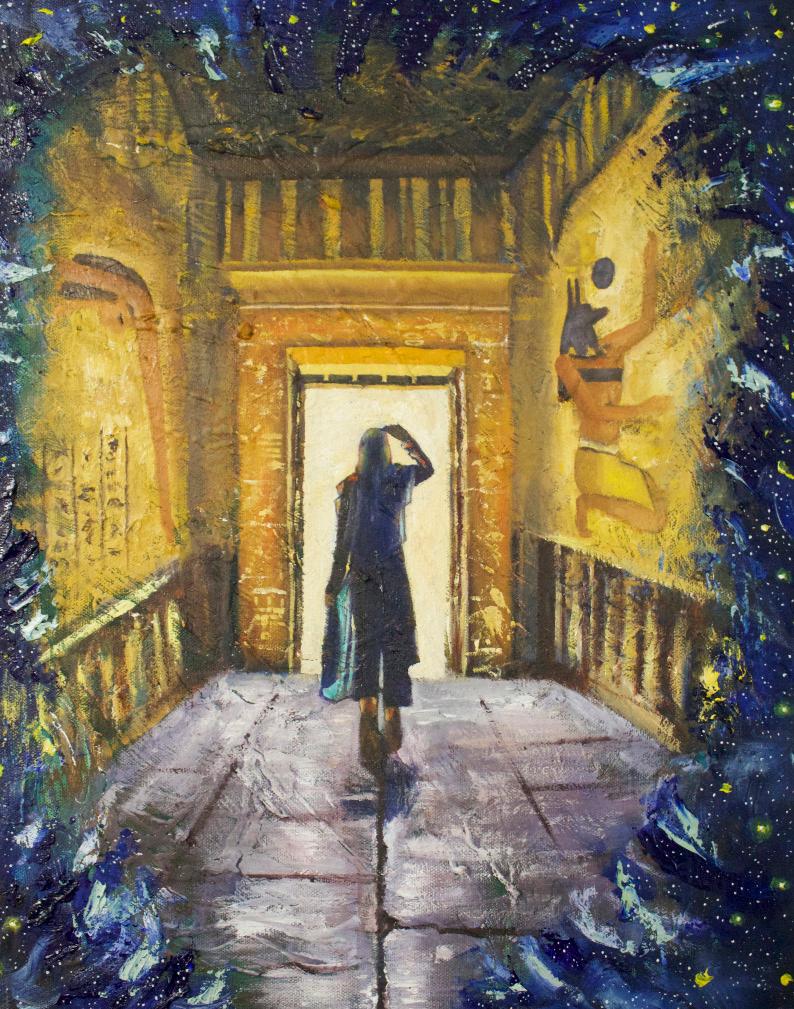

The ongoing battle between online and real life. AI image generators and their place in the art world
Across the country, leaves are changing color and falling from the branches by which they once hung. But in San Francisco? It’s been the hottest month of the year! So, whether you’re cozying up with a book or lying out under the sun, take a crack at our fall crossword, in spired by the stories from our latest issue. If you’re feeling stuck, check out our website and you might find a couple more clues.


1. Loud, fast-paced genre of rock.
3. Pictures on digital displays are made up of thousands of these.
5. A fictitious narrative of book length.
7. Reusing or recycling in a way that in creases the original quality of the item.
9. “It’s not just a ________, it’s a rock.”
11. To kill. Also, the name of a promi nent, early 2000s record label.
13. A _____ store sells mostly used/do nated clothing.
2. The fall gourd. Or is it a squash?
4. Not a committee but a _______.
6. To appoint democratically.
8. A work in progress, often used in reference to housing.
10. Models walk on this.
12. _______ stores sell mostly food and produce.
